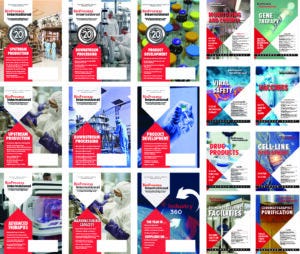- Sponsored Content
July-August: From the Editor
August 17, 2023
 We at BPI had so much fun putting together our big anniversary retrospective issue last year that we decided to make it an annual tradition starting this year — albeit on a bit smaller scale. There’s a lot to say when you reflect on 20 years of progress, problems, and solutions. But what can you say after only a year? Well, it turns out that the answer to that question, as you’ll find in these pages, is “Plenty!”
We at BPI had so much fun putting together our big anniversary retrospective issue last year that we decided to make it an annual tradition starting this year — albeit on a bit smaller scale. There’s a lot to say when you reflect on 20 years of progress, problems, and solutions. But what can you say after only a year? Well, it turns out that the answer to that question, as you’ll find in these pages, is “Plenty!”
 The past 12 months have been characterized primarily by a biopharmaceutical industry emerging from the dizzying pace of the pandemic into some kind of “new normal” that’s only now beginning to establish itself. That’s the main theme of this issue, and I’ll let the authors and interviewees speak for themselves herein.
The past 12 months have been characterized primarily by a biopharmaceutical industry emerging from the dizzying pace of the pandemic into some kind of “new normal” that’s only now beginning to establish itself. That’s the main theme of this issue, and I’ll let the authors and interviewees speak for themselves herein.
We’ve organized the main editorial contributions to this line-up in a general “top-down” approach, beginning with the big pictures of regulations and finance, then zooming into operations, manufacturing, and facilities, then finally landing on a personal career view. From another angle, you might notice that we begin with the historical perspective of one woman who’s been important to the biopharmaceutical industry since its inception and end with another who’s just beginning to make her mark. And from yet another angle, you might pick up on the threads of information technology (IT) and artificial intelligence that weave throughout the issue.
And that’s no surprise. Looking back at our 2022–2023 issues and special projects, I found IT to be the key theme that most stands out. Our September 2022 featured report on process monitoring and control set the mood with a deep-dive into data-driven, statistical, and mathematical modeling strategies (1). Those inevitably came up at least to some extent in later features on gene therapy, viral safety, vaccines, drug products, cell-line development, facilities, and purification. And whereas our October eBook highlighted due diligence in recording data, our April eBook offered some suggestions for analyzing collected results (2, 3). Then, we returned the process control theme for an eBook in March (4).
Meanwhile, a number of contributors to our regular issues focused on real applications of modern IT. In October, authors from Lesaffre and DPS describe how metabolomics and genome-scale modeling combine to provide a powerful platform for bioprocess optimization and fine-tuning of precision fermentation (5). In our November–December issue, Liz Beatty described how online platforms can be used to improve diversity, compliance, and outcomes in clinical research (6). Matthew Lakelin in the same issue cautioned about the criticality of tracking materials in personalized medicine (7). Our January–February 2023 issue followed with a heavy IT presence. Two articles addressed the challenges of hiring qualified personnel and developing their skills for digitalized biomanufacturing (8, 9). And authors from Amgen, a recognized leader in bioindustry 4.0, demonstrated the use of real-time, data-driven, and predictive modeling for drug-substance commercial manufacturing (10). Authors from Samsung Biologics continued the trend in our March issue with a focus on early assessments of chromatography column integrity using predictive algorithm modeling for production-scale downstream processing (11). Our April issue doubled down on the theme again with discussions of training for “biopharma 4.0” and leveraging intelligent automation and informatics for regulatory compliance, then provided a brief highlight of data integrity at advanced-therapy companies (12–14). May brought a conversation about digital transformation in biopharmaceutical operations at GSK (15). In June, Bayer authors described how they applied a multivariate, data-driven modeling application to monitor raw materials used in biomanufacturing (16). And even as we explored the many ways that software gets used across the biopharmaceutical industry, we learned that providers of those digital solutions need to work harder to expand awareness of what they can do for drug developers (17).
Software companies might consider contributing to our regular supplier-side section, where vendors and service providers can highlight their technologies and other offerings by citing real results. Over the past year, we’ve reported on significant developments in upstream production, downstream processing, analytical methods, and drug-product manufacturing both among our sponsored contributions and in our main technical articles. Continuous-processing options are expanding, as are applications of mass spectrometry. Both product- and process-related impurities have received well-deserved attention. And many companies discussed working with viruses, both as contaminants and as products themselves.
The industry is beginning to settle into a new groove of sorts. How that picture differs from the old one, I think, begins with biomanufacturing 4.0 — but doesn’t end with it. Many companies have learned a lot over the past few difficult years about logistics, material sourcing, and contingency planning. They’ve learned how to do many things quickly without compromising safety, quality, or regulatory compliance. And they’ve learned new ways of operating, partnering, financing, training, and networking. We’ve done our best to help you all share what you’ve learned, and we hope to continue in that vein between now and the 2024 “Industry 360” issue next summer (and beyond, of course).
All those changes in business and operations have come about in the industry while the underpinning science and biotechnology themselves have continued making the kind of impressive progress we’ve been talking about for the past couple decades. The pandemic actually accelerated some advancements while putting some projects on the back burner — and I think many of the latter will return to the forefront in the near future. In many ways, the past year has been a time of recovery, not only for the biopharmaceutical industry, but for much of the world. As you’ve heard me say before, I believe that working together will be key to emerging from adversity stronger, better, and wiser than ever before.
References
1 Monitoring and Control: Databased Solutions for Reducing Process Variability. BioProcess Int. 20(9) 2022; insert; https://bioprocessintl.com/september-2022-featured-report-monitoring-and-control-data-based-solutions-for-reducing-process-variability.
2 Sandle T, Vanderstel G, Huynh-Ba K. BPI Lab: Contemporary Approaches to Data and Organization. BioProcess Int. eBook October 2022; https://bioprocessintl.com/analytical/laboratory-equipment/laboratory-operations-contemporary-approaches-to-data-and-organization.
3 Sandle T. BPI Lab: Patterns, Peaks, and Trends — Advantages of Digital Data for Biopharmaceutical Quality Control. BioProcess Int. eBook April 2022; https://bioprocessintl.com/multimedia/ebooks/ebook-bpi-lab-patterns-peaks-and-trends-advantages-of-digital-data-for-biopharmaceutical-quality-control.
4 Gazaille B. Bioprocess Monitoring: Still on the Path to Dynamic Control. BioProcess Int. eBook March 2023; https://bioprocessintl.com/multimedia/ebooks/ebook-bioprocess-monitoring-still-on-the-path-to-dynamic-control.
5 Socolsky C, Whitford WG, Sourabié AM. Deciphering Nutritional Needs in Bioprocess Optimization: Targeted and Untargeted Metabolomics with Genome-Scale Modeling. BioProcess Int. 20(10) 2022; https://bioprocessintl.com/analytical/upstream-development/deciphering-nutritional-needs-in-bioprocess-optimization-targeted-and-untargeted-metabolomics-with-genome-scale-modeling.
6 Beatty L. Increasing Clinical Trial Inclusivity: Technology-Enabled Community Connections. BioProcess Int. 20(11–12) 2022; https://bioprocessintl.com/2022/november-december-2022/increasing-clinical-trial-inclusivity-technology-enabled-community-connections.
7 Lakelin M. Managing Patient Data in the Supply Chain. BioProcess Int. 20(11–12) 2022; https://bioprocessintl.com/2022/november-december-2022/managing-patient-data-in-the-supply-chain.
8 Beckwith J, et al. The Talent Enigma in Digital Biomanufacturing. BioProcess Int. 21(1–2) 2023; https://bioprocessintl.com/business/careers/the-talent-enigma-in-digital-biomanufacturing.
9 Farid SS, et al. Delivering the Digital Skills Needs of the Bioprocessing Sector: Realizing the Vision of Industry 4.0 for Your Organization. BioProcess Int. 21(1–2) 2023; https://bioprocessintl.com/business/careers/delivering-the-digital-skills-needs-of-the-bioprocessing-sector-realizing-the-vision-of-industry-4-0-for-your-organization.
10 Rosado PJ, Merheb B, Toro A. Real-Time, Data-Driven, and Predictive Modeling: Accelerating Digital Transformation in Drug Substance Commercial Manufacturing. BioProcess Int. 21(1–2) 2023; https://bioprocessintl.com/analytical/pat/real-time-data-driven-and-predictive-modeling-accelerating-digital-transformation-in-drug-substance-commercial-manufacturing.
11 Kim N, et al. Predictive Algorithm Modeling for Early Assessments in Downstream Processing: Using Direct Transition and Moment Analysis To Assess Chromatography Column Integrity at Production Scale. BioProcess Int. 21(3) 2023; https://bioprocessintl.com/downstream-processing/chromatography/predictive-algorithm-modeling-for-early-assessments-in-downstream-processing-using-direct-transition-and-moment-analysis-to-assess-chromatography-column-integrity-at-production-scale.
12 Loebel K-H, Nichols J. Overcoming the Digital Divide: Leveraging Intelligent Automation and Informatics Expertise. BioProcess Int. 21(4) 2023; https://bioprocessintl.com/manufacturing/information-technology/overcoming-the-digital-divide-leveraging-intelligent-automation-and-informatics-expertise.
13 Beckwith J, et al. Biopharma 4.0 — the Talent Evolution. BioProcess Int. 21(4) 2023; https://bioprocessintl.com/manufacturing/information-technology/biopharma-4-0-the-talent-evolution.
14 Pang K. Strengthening Data Management and Integrity for CGT Applications. BioProcess Int. 21(4) 2023; https://bioprocessintl.com/manufacturing/cell-therapies/strengthening-data-management-and-integrity-for-cgt-applications.
15 Edmunds D, Artico F. Digital Transformation in Biopharmaceutical Operations. BioProcess Int. 21(5) 2023: 24–25; https://bioprocessintl.com/manufacturing/information-technology/digital-transformation-in-biopharmaceutical-operations.
16 Wei H, Mason J, Spetsieris K. Continued Process Verification: A Multivariate, Data-Driven Modeling Application for Monitoring Raw Materials Used in Biopharmaceutical Manufacturing. BioProcess Int. 21(6) 2023; https://bioprocessintl.com/upstream-processing/biochemicals-raw-materials/continued-process-verification-a-multivariate-data-driven-modeling-application-for-monitoring-raw-materials-used-in-biopharmaceutical-manufacturing.
17 Sheehy D. Meeting Biopharmaceutical Market Needs: What Digital Solutions Need To Succeed. BioProcess Int. 21(6) 2023; https://bioprocessintl.com/2023/june-2023/meeting-biopharmaceutical-market-needs-what-digital-solutions-need-to-succeed.
Cheryl Scott is cofounder and senior technical editor of BioProcess International, part of Informa Connect Life Sciences; 1-212-600-3429; [email protected].

You May Also Like





